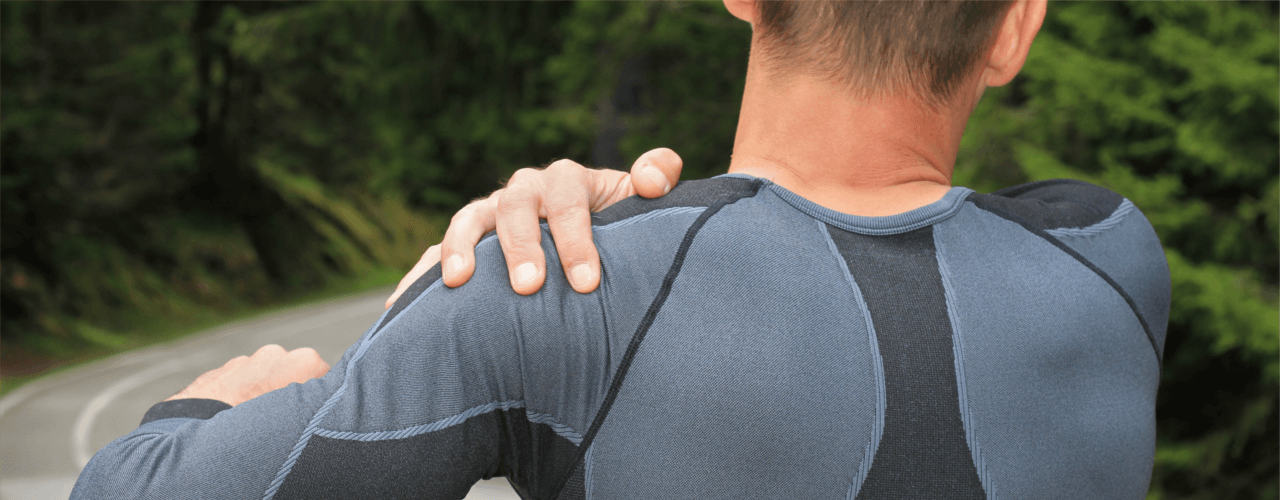We never really think about how much we use our shoulders in daily life until we experience shoulder pain. Your day is probably filled with reaching, lifting, stretching, picking things up and other activities that involve your shoulders. As a result, shoulder pain can reduce your quality of life in a big way. Almost every type of shoulder pain can be alleviated and treated with physical therapy. If you’re living with severe shoulder pain, don’t hesitate to give us a call and schedule a consultation with a physical therapist.
What is Shoulder Pain?
“Shoulder pain” is really just a generic term for something that makes your shoulder area hurt. The shoulder is a complicated ball and socket joint that includes your collarbone (clavicle), your upper arm bone (humerus) and the shoulder blade itself (scapula). The shoulder has ligaments and muscles attached to it from your back, chest and arm. An injury or debilitating condition to any of those attachments, bones, ligaments or muscles can lead to “shoulder pain.”
The only question is, how serious is the pain? Some types of shoulder pain are so severe that it can completely restrict your movement — for months at a time. If it is an ongoing pain that doesn’t seem to be getting better, you should seriously consider physical therapy for pain relief and to help you recover.
Causes of Shoulder Pain
Here’s a closer look at the different causes and types of shoulder pain:
- Fracture: A shoulder fracture usually happens as a result of a sudden trauma, such as a car accident or a collision during a sporting event. Any or all three of the bones that meet at the shoulder joint can be impacted (collarbone, scapula, and humerus). The most common cause of a shoulder fracture is simply falling and catching yourself on one hand — like football players do every single day!
- Rotator Cuff Tendonitis: The four main muscles that allow you to move your shoulder make up the rotator cuff. These muscles help hold the ball of the humerus in your shoulder socket while you move your arm. The tendons from these muscles attach to each other underneath the shoulder blade. If one of those attachments gets pinched due to an injury the result is tendonitis (and sometimes very intense shoulder pain).
- Bursitis: We all have fluid-filled sacs in our bodies that help certain structures glide over each other. These sacs are called bursa, and one of them sits between the shoulder blade and the arm bone. If the bursa gets pinched, it leads to shoulder bursitis.
- Frozen Shoulder: The technical name for a frozen shoulder is adhesive capsulitis. This condition comes on slowly and it cannot be identified with an X-ray or MRI. Eventually, the use of the shoulder becomes so severely restricted that it becomes too painful for everyday activities, such as reaching into your back pocket or putting on a belt. It’s believed that a buildup of scar tissue in the shoulder muscles could be one of the causes of this mysterious and painful condition.
Physical Therapy for Shoulder Pain
Your physical therapist will start the process of dealing with your shoulder pain by evaluating it. You’ll be asked questions about the cause of the pain, how severe it is, what makes it worse and whether anything makes it feel better. The physical therapist will conduct some tests to determine the range of motion in your shoulder and test its strength.
Depending on the cause of your shoulder pain, your therapist will begin a recommended course of treatment to improve your range of motion and start the healing process. This can involve pain management, such as identifying painful motions or activities and figuring out ways to avoid those. Your treatment will likely involve manual therapy, such as soft tissue massage, as well as range-of-motion exercises to help improve the function of your shoulder muscles and ligaments. Strengthening exercises may or may not be a part of your treatment, depending on the diagnosis. It’s important that you follow your physical therapist’s advice, so you can properly heal.
If you’re suffering from shoulder pain as a result of an injury, call us today at Oviedo and Orlando, FL centers to schedule an appointment with a physical therapist. We’ll get you back on the path to healing as quickly as possible!






